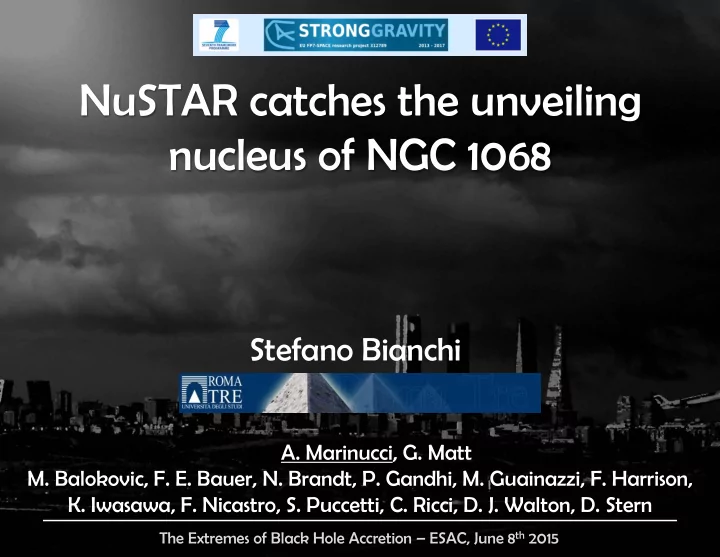

NuSTAR catches the unveiling nucleus of NGC 1068 Stefano Bianchi A. A. Marinucci, G. Matt M. Balokovic, F. E. Bauer, N. Brandt, P. Gandhi, M. Guainazzi, F. Harrison, K. Iwasawa, F. Nicastro, S. Puccetti, C. Ricci, D. J. Walton, D. Stern The Extremes of Black Hole Accretion – ESAC, June 8 th 2015
While the AGN unified picture remains valid in its more general sense NLR (the presence of non-spherically symmetric absorbers at the origin of the type 1/type 2 dichotomy), several new observations and models, mostly in the X-ray and infrared domain, BLR suggest that multiple absorbers are present around the central source, on quite different physical scales (e.g. BLR Bianchi, Maiolino & Risaliti 2012) Torus On scales of hundreds of parsecs, or even larger (galactic dust lanes), circumnuclear matter has been imaged, and is clearly responsible of the “type 2” (in optical/UV) or “absorbed” (in X-rays) classification of a significant fraction of AGN On the parsec scale , and down to the dust sublimation radius, the “standard” torus has been directly imaged in a few sources with interferometric techniques, and its presence is suggested by X-ray reflection properties, and dust reverberation mapping in the near-IR On the sub-pc scale, dust-free gas along the line of sight has been observed through X-ray absorption variability: part of the observed X-ray absorption is due to BLR clouds Antonucci & Miller, 1985
NGC 1068 is the archetypical and one of the brightest Compton-thick Seyfert 2 galaxies in the sky It is obscured by Compton-thick material along the line of sight and its spectrum is completely dominated by reprocessing: hot (He- and H-like iron lines), warm (low-Z ionized lines) and cold (Iron Ka , EW=1.3 ± 0.4 keV) With a BH mass of ~10 7 M sun (Kuo et al., 2011) and a bolometric luminosity of 8 x 10 44 erg s -1 (Pier et al., 1994) the source is accreting at a high Eddington ratio and therefore it is expected to be intrinsically very variable Guainazzi et al. (2000) NGC1068 is an ideal target to study the circumnuclear material through variability! Evidence of flux variability of both the cold and ionized reflectors has been claimed on time scales of months and years (Guainazzi et al., 2000; Colbert et al., 2002; Matt et al., 2004) Guainazzi et al., 2000
We observed NGC 1068 with a joint XMM- Newton and NuSTAR monitoring campaign, from July 2014 until February 2015 Longer time-scales can be probed thanks to the two previous XMM- Newton observations performed in 2000 (Matt et al. 2003), and the NuSTAR observation performed in 2012 (Bauer et al, 2014)
Recently, Bauer et al. (2014) analysed NGC 1068 using data from different observatories, including the 3-79 keV data from the NuSTAR 2012 observation They interpreted the broadband cold reflected emission of NGC 1068 as originating from multiple reflectors with three distinct column densities. Bauer et al. (2014) The higher N H component (N H,1 ≃ 10 25 cm −2 ) contributes most to the Compton hump (and is also responsible for the total suppression of the intrinsic continuum), while the lower N H component (N H,2 ∼ 1.5 × 10 23 cm −2 ) produces much of the neutral iron line emission Almost 30% of the neutral Fe K α line flux arises from regions outside the central 140 pc and is clearly extended (see also Young et al, 2001; Ogle et al., 2003)
We start our analysis checking for variability in the four XMM- Newton spectra of our campaign. No variability is found between them, and with respect to the spectrum taken in July 2000 The neutral Iron K α line is constant within 5% Although the intrinsic variability is unknown, this suggest that most of the line/reflection is produced far away 2000 2014/15 Bianchi et al., in prep. The forbidden component of the OVII K α line triplet is constant within 1% We know that it is produced in an extended emission coincident with the NLR, but e.g. NGC5548 (Detmers et al. 2009) Bianchi et al., in prep.
Above ~15 keV, a clear excess (~30%) is present in the August 2014 NuSTAR spectra! Marinucci et al., in prep. This variation strongly suggests an unveiling event in NG1068 due to a change of the absorbing column density along the line of sight and/or a brightening of the intrinsic continuum. We test this scenario adopting the Bauer+14 model to fit the multi-epoch data and leaving only the primary component (N H and flux) free to vary
2012 Marinucci et al., in prep. 2014 2015 The intrinsic X-ray luminosity for the three NuSTAR observations is consistent with the ones inferred using other proxies ([OIII], mid-IR) if all the spectral difference can be attributed to a change in the absorbing column density, from N H ~10 25 cm −2 in 2012/2015 to N H ~6 × 10 24 cm −2 in 2014
Conclusions We interpret the high-energy excess detected in the August 2014 NuSTAR spectra as the first unveiling event ever observed in NGC 1068, in which there is a drop in the column density along our line of sight Other interpretations are unlikely: a variation in the Compton hump without an associated variation in the iron line requires the reflector to be almost completely self-obscured (inclination angle > 87 ◦ ) X-ray absorption variability has been found on time scales of hours to years in several sources (e.g. Bianchi, Maiolino & Risaliti, 2015). However, thanks to the unprecedented sensitivity and broad spectral band covered by NuSTAR, this is the first time ever that a fully Compton-thick unveiling event affecting only above 10 keV is reported. This finding is another strong piece of evidence in favour of the clumpiness of the obscuring gas in AGN, and of the presence of circumnuclear material at all distance scales
Recommend
More recommend